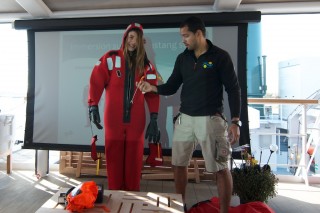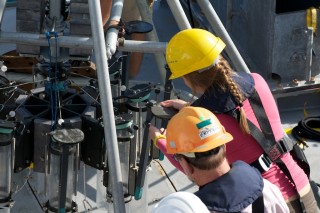For the past two days, the science team has been busily unpacking boxes, assembling instruments, and getting oriented on R/VFalkor in preparation for the upcoming cruise. Lists were checked and rechecked to ensure that all the necessary supplies were on hand. Scientists send or pack all their sample bottles, experiment supplies, computers, measurement tools, batteries, and anything else they need for their studies at sea. They usually bring backups of critical items, too, just in case. Once the ship sets sail, you can’t run to the local store or order items that you forgot.

In many cases, scientists must reassemble larger instruments that had to be shipped in separate containers due to their size. Graduate student Mauricio Silva Aguilera had just this task to build the multicore instrument that will be used to collect cores of sediments from seafloor. He worked late into the evening connecting the frame and pieces together like a big IKEA furniture puzzle. It also takes many hours to secure equipment and supplies as the motion of a moving ship–especially when weather turns rough–can knock over any object that is not tied down or anchored in some way to the ship.
Safety First

Knowing how to work safely and what to do in an emergency are critical requirements for everyone onboard the ship. This morning, all of the science team participated in a safety orientation and drill for R/VFalkor. We learned the distinctive alarm bell sequences that indicate whether there is a fire, a man overboard, and/or a command to abandon ship. We practiced putting on immersion suits and life jackets for protection.
Underway
R/V Falkor set sail from Pascagoula just before noon. In a few hours, the ship reached a site where the scientists and crew could test the deployment of the multicore instrument. A series of additional equipment tests are planned for tomorrow before the scientific collections with the ROV and multicore begin on Wednesday.
